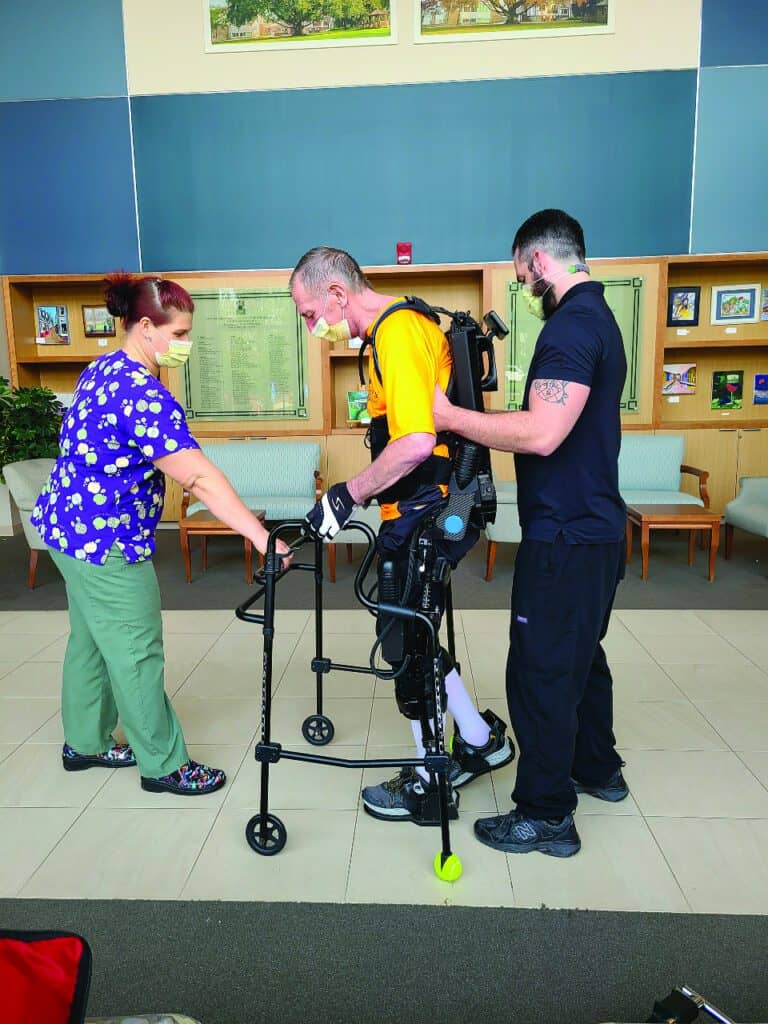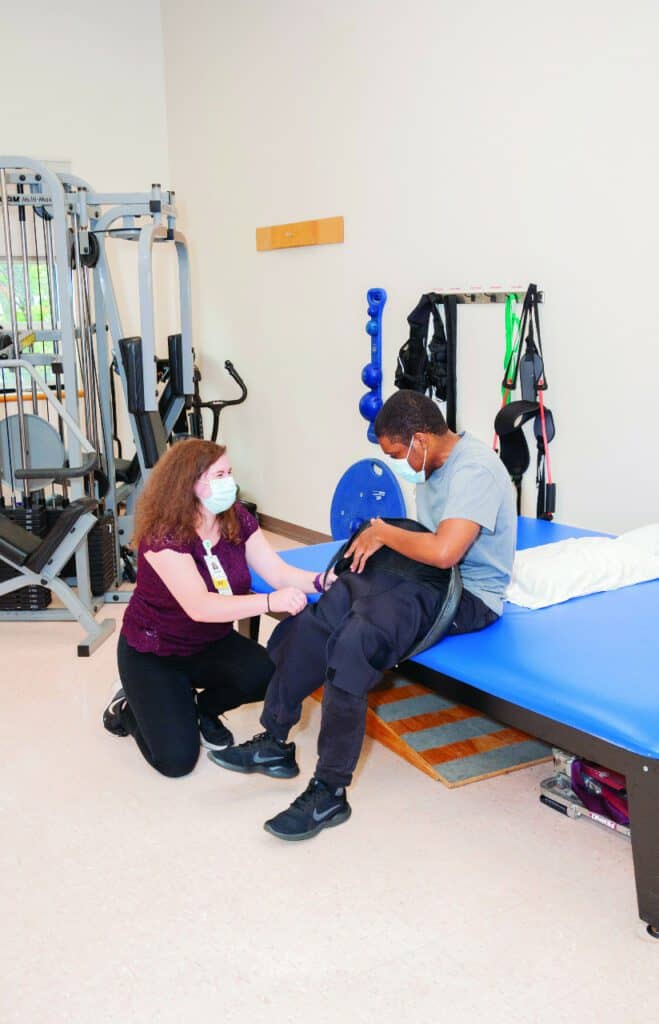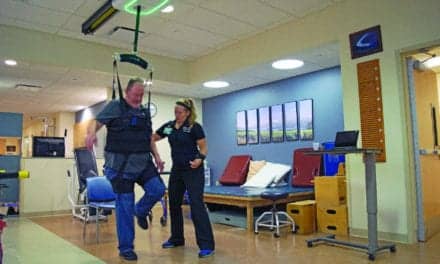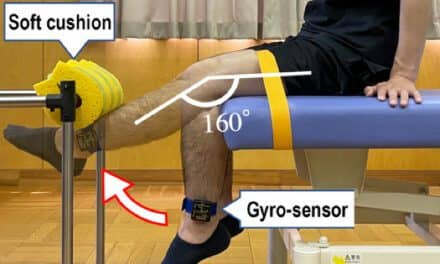CAPTION: Kaila Morin, PT, DPT, guides a patient using the AlterG. This specialized treadmill inflates with air to offset the patient’s weight while walking and tracks gait nuances via camera and data logged in the system. (Photo: Karen Ingham Photography)
Equipment that provides data to track patient progress helps motivate clients and guide therapists in how to achieve the best health outcomes.
By Melanie Hamilton-Basich
Monitoring a patient’s physical therapy progress is not simple, but equipment designed to assess and track improvements using concrete data can surely help. At Gaylord Specialty Healthcare in Wallingford, Conn, therapists routinely use these solutions to help lay the groundwork for a plan of care as well as communicate more clearly with patients.
“With these solutions you can gather data and educate and talk with patients about how they’re doing in a meaningful way,” says Kaila Morin, PT, DPT, Outpatient Physical Therapist, Level 2 Traumatic Brain Injury Specialist at Gaylord. “It’s really good for motivation and showing progress. And you can get that real-time data and adjust as necessary then, not wait until after they’re finished, which is helpful, too.”
Ekso Bionic Exoskeleton
The Ekso Bionic Exoskeleton from Ekso Bionics, Richmond, Calif, is a device that Gaylord’s therapists use as an adjunct to standard physical therapy to improve gait by helping the patient take a more normal step, says Tim Kilbride, PT, DPT, Inpatient Physical Therapist, Level 3 Spinal Cord Injury Specialist.
“After it’s programmed to the patient’s specifications, the Ekso will give me constant feedback about how much assistance it’s providing to the patient, and where the patient is not meeting the predetermined path that they’re supposed to be on,” Kilbride explains. “So if the patient is taking too short of a step, or if they’re not lifting their foot high enough, it will let me know so I can cue the patient through manual or verbal cues.”

Using this equipment identifies specific issues with a person’s gait so the therapist knows what areas to address, and also allows the patient to practice specific techniques through repetition. “The idea is to carry over those accurate and well-placed steps into walking with the regular therapist,” Kilbride says.
The Ekso might be used multiple times a week for the duration of treatment, depending on the patient’s needs, which generates a great repository of data over time. And the equipment is not limited to standard walking. It can also be used to practice techniques for doing squats, walking backwards, and sidestepping.
“Being able to have more concrete information rather than more of a subjective description of how a patient is doing helps pretty much down the line,” Kilbride adds. “In guiding where their therapy goes, communicating to insurance companies about the progress that the patient has made, and even planning out the next session of Ekso.”
AlterG Anti-Gravity Treadmill
Another piece of data-based therapy equipment used to improve a person’s gait pattern is the AlterG Anti-Gravity Treadmill from Fremont, Calif-based AlterG. Once filled with air, the treadmill can be programmed to offset the body weight of the patient placed in it, making it ideal for treating a wide variety of neuro and orthopedic conditions. These could include a weaker side caused by a stroke or incomplete SCI, or an orthopedic condition causing pain with weight-bearing. It can also be used for higher-level patients to help them get back to jogging or running.
A camera allows for visual real-time feedback, while the equipment also provides data regarding step length, cadence, and how much body weight support it’s giving the patient. Looking at the data, the therapist can determine what adjustments would be beneficial and can make them then and there. Morin, the outpatient physical therapist who most often uses this equipment at Gaylord, says sometimes she will use trial and error. If she’s offweighting someone to 20%, she’ll start decreasing the increment by 1% to gradually wean them off of the assistance. Or she might adjust it by 5% and see how the patient reacts to the difference in the moment.

But patients have the ability to make adjustments based on biofeedback as well. “If the person’s steps are not equal, they can self-correct based on the data they’re getting,” adds Jacob Hunter, PT, MSPT, OCS, Senior Director of Outpatient Clinical Services at Gaylord. “And you have video, so you can watch videos of how they’re stepping. If they’re catching their right foot a bit, you can ask them to pick up their leg a little higher. You can see the numbers and see what they’re actually doing, too.”
Over time, if the patient’s steps while walking on a flat surface look good, the therapist can also add an incline or have the patient start walking backward or sideways to incorporate different muscle groups and gait training. Constant feedback helps patients make these improvements.
“Lots of people like seeing what their feet and legs are doing. Instead of just walking outside of it and looking down at their feet, it’s a safer way to see their feet without looking down,” Morin says. “But also, if you show them the numbers, it makes sense to them. It helps them understand what we’re trying to get them to accomplish.”
The data also helps pinpoint other types of therapy the patient would benefit from, and is often used in combination with other gait training, balance training, and overall strengthening.
KINESIQ
For balance training, many patients benefit from the KINESIQ interactive multisensory virtual reality (VR) tool from Canadian company KINESIQ. This includes anyone with a neurological diagnosis such as multiple sclerosis, stroke, or incomplete brain injury, as well as amputees and patients with vestibular dysfunctions.
“It’s usually my go-to for concussion patients if they can tolerate it,” Morin shares. Some patients experience too much nausea or dizziness in the beginning because the system and its VR game experience so accurately mimics motion.
Diminishing intensity of these symptoms can signify progress. “Symptoms are subjective, but the reports can show me if they’re putting more weight on their left side vs their right, show their center of gravity, and their ability with activities while moving forward, backward, and side to side,” she says.
How long the patient stays on target is also very important data for determining progress. As is how long they can hold their balance on target, particularly on a side of the body that is weaker. If they’re successfully able to react in an appropriate way, Morin might increase the speed or intensity of the program to help them progress further.
Being able to share progress is a great motivator. “It shows the percentage of how long they’re maintaining their balance on target,” Morin explains. “Say you can show them that they’ve improved from 50% to 75%. They find that meaningful. But they like the system too because it’s more fun than traditional therapy, which is its own form of motivation.”
Morin says KINESIQ is a good adjunct with other therapy techniques. She typically uses the system along with traditional balance training on foam pads or booster balls. Depending on the patient, gait training might be a goal as well. In such a case, being able to reach a longer stance time on the weaker side could lead to a more normalized gait pattern. But generalized strengthening or endurance training may also be helpful. Using the KINESIQ, patients feel like their calves or thighs are getting a good workout, even if they’re not doing traditional “walking.”
Meaningful Progress
Data-based therapy has helped Gaylord Specialty Healthcare therapists make a real difference for numerous patients, such as a woman being treated for her post-COVID-19 symptoms, including severe shortness of breath. She loved to run and was terrified that she would never be able to exercise again. Until one session when she was able to run while training with her therapist in the AlterG. She broke down crying because she was so appreciative.
“She thought her running days were over, but this piece of technology bridged that gap for her and gave her hope again,” Hunter says. “What this technology really allows us to do is show, this is where you started and here is how far you’ve come. And that is so important to keep patients motivated and engaged.
“Because it’s all too easy for patients to focus on where they are not. This technology helps to show them how much progress they truly have made.” PTP





